ISSN ONLINE(2319-8753)PRINT(2347-6710)
ISSN ONLINE(2319-8753)PRINT(2347-6710)
| Dr.G.Brindha Associate professor, Dept Of MBA, Bharath University, Chennai – 600073, India |
| Related article at Pubmed, Scholar Google |
Visit for more related articles at International Journal of Innovative Research in Science, Engineering and Technology
The management and control of inventory is a problem common to all organizations in any sector of the economy. The wealth of shareholders also lies in the warehouse. More than 60% of working capital is normally being invested in the inventory. There can be disadvantages in holding either too much or too little inventory. Therefore inventory management is primarily concerned with obtaining correct balance between two extremes. Inventory management involves the development and administration of policies, system and procedures which will minimizes total cost relative to inventory decisions and related functions such as customer service requirement, production scheduling, purchasing etc.., Viewed in that perspective, inventory management has a broad scope and affects a great or number of activities in an Organization. For the past few years the concept of inventory system has gained more importance in our country. It is due to intense competition in the market, which has forced organizations to search for proper inventory control technique to reduce investment in inventories and thereby reducing overall cost.
INTRODUCTION |
| Inventory is essential to provide flexibility in operating a system. The inventory can be classified into raw materials inventory, in-process inventory and finished goods inventory. The raw materials inventories remove dependency between suppliers and plants. The work-in-process inventories remove dependency between machines of a product line. The finished goods inventory removes dependency between plant and its customers/market. Inventory management is one of the important components of working capital management. It involves the progress of providing continuous flow of raw materials to production department. More than 60% of the working capital will normally be invested in the inventory. There can be disadvantage in holding either too much or too little inventory. Therefore, inventory management is primarily concerned with obtaining a correct balance between these two extremes. Decisions relating to inventory are taken primarily by executives in production, purchasing & marketing departments. Usually raw materials policies are shaped by purchasing & production executives and finished goods inventory policy is evolved by production and marketing executives. Yet, as inventory management has important financial implications the financial manager has the responsibility to ensure that inventories are properly monitored and controlled. |
| Functions: |
| ïÃâ÷ Smoothing out irregularities in supply. |
| ïÃâ÷ Minimizing the production cost. |
| ïÃâ÷ Allowing organizations to cope with perishable materials |
| Objectives: |
| ïÃâ÷ Effective use of financial resources available to business i.e., to maintain the investments inventory at the lowest level consistent with operating requirements. |
| ïÃâ÷ Avoidance of the “out-of-stock” danger, i.e., to provide a supply of required materials without and delay for efficient and uninterrupted operation. |
| ïÃâ÷ Reduction to a minimum of the risk through obsolescence. |
| ïÃâ÷ Economy in purchasing is effected quantity buying and favorable raw materials market. |
| ïÃâ÷ Storage of inventory with a minimum of handling time and cost and to protect them from losses by theft, and in damage. |
| ïÃâ÷ Service to customers, i.e. maintaining sufficient stocks of finished products to meet reasonable expectation of customers for prompt delivery of their orders. |
| ïÃâ÷ Accurate and regular material reports to management by keeping perpetual inventory and other up-to-date records. |
II.TYPES OF INVENTORY |
| The three main types of inventories are raw materials, work-in-progress, & finished Goods. |
| Raw Materials: |
| Raw Materials is an unprocessed natural substance or product used in Manufacturing Process and that are converted by a manufacturer into a finished product. There are the goods which have not yet been committed to production in a manufacturing Firm. They consist of raw materials or finished components. They may consist of raw materials or finished components. They are the resources purchased as inputs to the transformation process that have not yet been transformed. Materials suitable for manufacture or use or finishing is raw material. Raw material is the original material as taken from its source, usually the ground. |
| Work-in-Progress: |
| Work-in progress, also called stock-in-progress, refers to goods in the intermediate stages of production. This includes those materials which have not yet been completed. It refers to the raw materials engaged in various phases of production schedule. The degree of completion may be varying for units. Some units might have been just introduced and some others may be 40% complete or others may be 90% complete. The work-in-progress refers to partially produced goods. |
| The value of work-in-progress refers to raw materials costs, direct wages, and expenses already incurred and the overhead if any. So work-in-progress inventory contains partially produced/completed goods. The purpose of work-inprogress inventory is to uncouple the various operations in the production process so that machine failures and stoppages in one operation will not affect other operations. |
| Finished Goods: |
| Inventory that is in a saleable or shippable form based upon its location within the supply chain. Finished goods are completed products awaiting sale. They are the final output of the production process in a manufacturing firm. An item considered a finished good in a supplying plant might be considered a component or raw materiel in a receiving plant. Commodities that will not undergo further processing and ready for sale to the final demand user, either an individual consumer or business firm. In case of wholesalers and retailers, they are generally referred to as merchandise inventory. This includes durable goods such as automobiles, household furniture and appliances, And Nondurable goods such as apparel and home heating oil. |
| High & low level of Inventory: |
| Inventory control involves a tight rope walk between two conflicting goals- not to have too high an inventory level, & not to have too low as well. The relative benefits arising out of keeping high & low levels of inventories are briefly presented in the following table: |
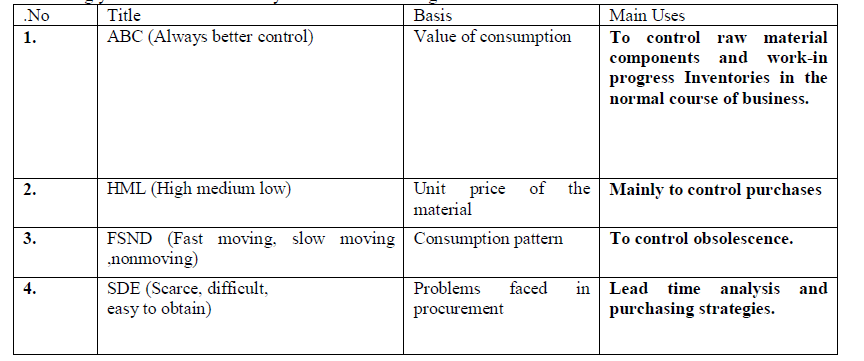 |
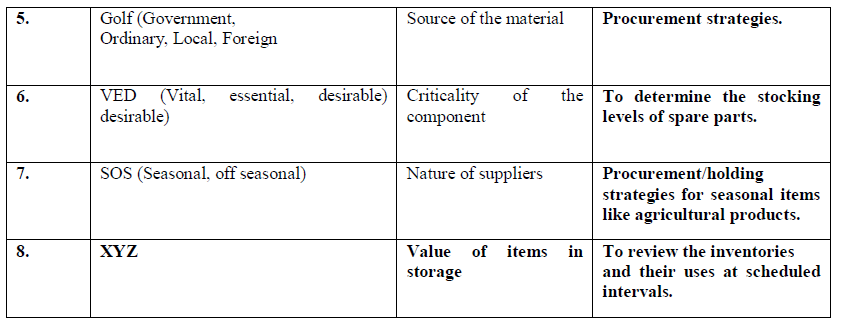 |
| Periodic review system: |
| In this system of inventory, the stock position is reviewed once in a fixed period and an order is placed depending on the stock position, unlike a fixed quantity in the Q system of inventory. The review period is approximately equal to EOPQ/D. The Desired Maximum Inventory Level is fixed as the sum of the average demand during average lead time plus review period, variation in demand during average lead time plus review period, and the average demand during delays in supply. A schematic representation of this model is shown in figure. |
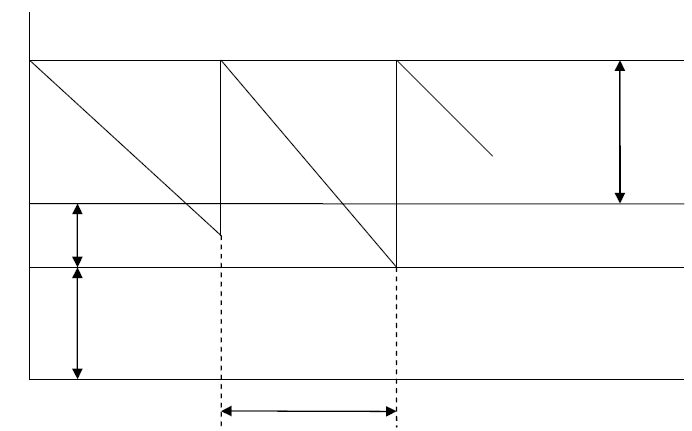 |
| Maximum Inventory Level during lead time and review period Units |
| Reserve stock during delivery |
| Safety stock during lead time and review period |
III.SYSTEM OF INVENTORY |
| Tools of Inventory management: |
| Effective inventory management requires control over inventories. Inventory control refers to a system which ensures supply of required quantity and quality of inventories at the required time and at the same time prevents unnecessary investment in inventories. The tools of inventory control / inventory management are as follows: |
| (I) ABC analysis: |
| The ABC method is an analytical method of stock control which aims at concentrating efforts on those items where attention is needed most. It is based on the premise that a small number of the items in inventory may typically represent the built money value of the total materials used in production process, while a relatively large number of items may represent a small portion of the money value of stores used and that small number of items should be subject to the greater degree of continuous control. |
| Under this system, the materials stocked may be classified into a number of categories according to their importance, i.e., their value and frequency or replenishment during a period. The first category, we may call if the group of ‘A items may consists of only a small percentage of total items handled but its combined value may be large portion of the total stock value. The second category, naming it as group of B items may be relatively less important. In this third category, consisting of C items, all the remaining items of stock may be included which are quite large in number but their value is not high. |
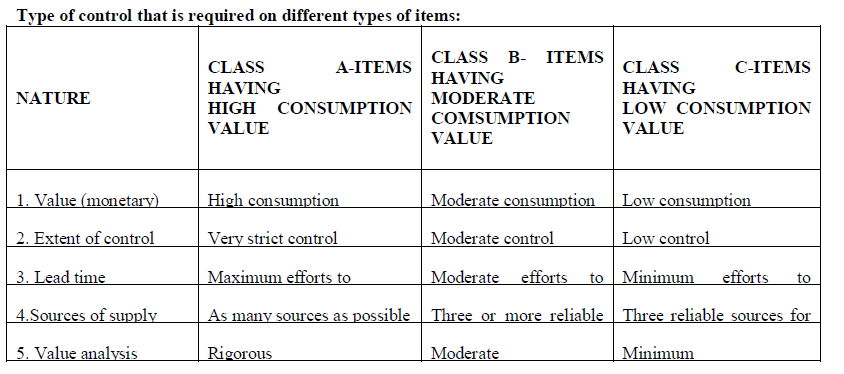 |
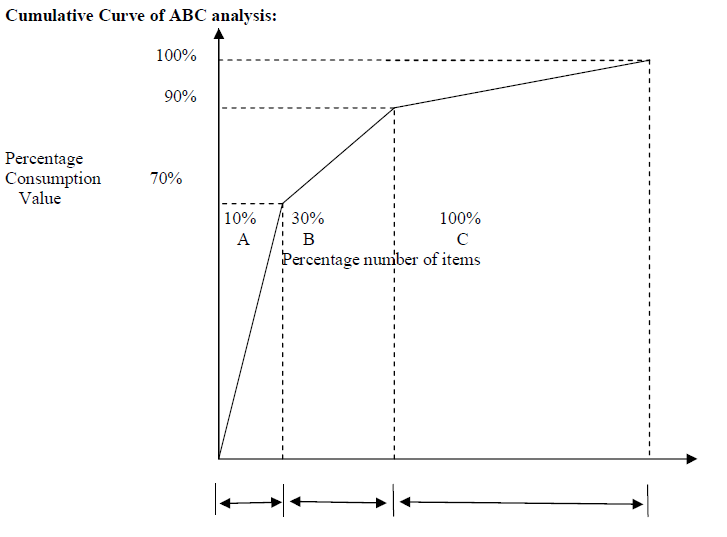 |
| Application of ABC analysis: |
| This approach helps the materials manager to exercise selective control and focus his/her attention only on a few items when he/she is confronted with thousand of stores items. Any stock control system should ensure that every item gets its due attention at the right time. ABC analysis makes it possible with considerable less effort by its selective approach. The following are the applications of ABC analysis. |
| (A) Degree of control: |
| 'A’ class items form a substantial part of total consumption in rupees. Greater attention should be paid and accurate records maintained for these items. The inventory should be kept at a minimum by placing blanket orders, covering annual requirements and then arranging frequent delivers from vendors. ‘B’ class items should have normal or moderate control made possible, by good records and regular attention. A little or no control is required for ‘C’ class items. Large inventories should be maintained to avoid stock-outs. |
| (B) Ordering procedure: |
| ‘A’ class items require careful and accurate determination of order quantities and order points based on exact requirements. They should be subjected to frequent reviews to reduce possibility of overstocking. A reasonably good analysis for order quantities and order points is required for ‘B’ class items but the stock may be reviewed less frequently or only when major changes occur. No such computations are required for class items. These items should be bought in bulk, may be for a whole year. |
| (C) Stock records: |
| Detailed records of goods reserved, received, ordered, issued and on hand need to be maintained for ‘A’ class items. Tight and accurate controls are required for such items. No such detailed records are necessary for the ‘C’ class items. Any routine method that ensures good and accurate records is enough for ‘B’ class items. |
| (D) Priority treatment: |
| Top priority may be accorded to ‘A’ class items in all activities such as processing of purchase orders, receiving, inspection, movement on the shop floor, etc., with an object to reduce lead time and average inventory. No such priority is necessary for B class items. Normal plant procedures should take care of inward and outward flow of these items. No priority is assigned to C class items at all. |
| (E) Safety stock: |
| Shortage may occur even when accurate and realistic order points have been computed. Safety stock is provided to safeguard against such shortages. Safety stock should be less for ‘A’ class items. The possibility of stock-outs can be cut down considerably by closer forecasting, frequent reviewing and more processing. A moderate policy is requires for ‘B’ class items. Safety stock should neither be too high or too low. ‘C’ class items on the contrary, should have sufficient safety stock to eliminate stock-outs. |
| (G) Value analysis |
| To secure maximum benefits, it is essential to select those items for value analysis which offer the highest scope for cost reduction. |
| Advantages of ABC analysis: |
| 1. Closer and strict on those items which represent a major portion of total stock value. |
| 2. Investment in inventory can be regulated and funds can be utilized in the best possible manner. |
| 3. Saving in stock carrying costs. |
| 4. Helps in maintaining enough safety stock for ‘C’ category of items. |
| 5. Scientific and selective control helps in maintenance of high stock turnover rate. |
| (II)Economic order quantity: |
| The economic order quantity refers to the quantity ordered to be purchased at the lowest total cost. This is the most economical purchase quantity which maintains a balance between two opposing costs of procurement and carrying. The economic order quantity is also known as economic lot size. So, the quantity to be ordered at a time is determined by the cost of procurement and the cost of carrying the inventories. The EOQ will be the one where the costs of procurement and the cost if carrying are equal. At this point the total cost is minimum. It can be graphically illustrated in the following diagram. |
| In the above diagram, AP is the inventory procurement cost curve which indicates that per unit cost of procurement is lower for more quantity purchased and vice versa. IC is the inventory carrying cost which shows that per unit cost of carrying rises with the increase in the quantity purchased. BT is the total per unit cost which is minimum at point N where inventory procurement cost equals with the inventory carrying cost. Hence, OQ is the EOQ or economic lot size. If more than OQ is purchased, it will raise the total cost which is uneconomical. |
 |
| representation of EOQ |
| Bulk buying reduces the frequency of ordering and therefore, the ordering costs. The determination of EOQ is primarily intended to balance the ordering costs and the carrying costs. |
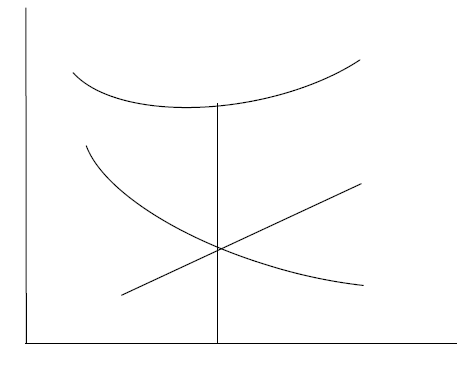 |
| EOQ can be determined with the help of the following formula: |
| A = Annual Consumption |
| O = Ordering Cost per order |
| C = Carrying Cost per unit |
| Cost associated with EOQ: |
| (I) Ordering cost: |
| Ordering costs relates to purchased items that include expenses on the following. Requisitioning, preparation of order, expediting, transport and receiving and placing in storage. Ordering costs pertaining to items manufactured in the company would include expenses on the following. Requisitioning, setup and receiving and placing storage. |
| (II) Carrying or Stockholding Costs: |
| These are costs associated with carrying one unit of the raw material in stock. It includes |
| ïÃÆÃË Interest on working capital blocked in raw material inventory |
| ïÃÆÃË Storage Insurance |
| ïÃÆÃË Warehousing Charges |
| ïÃÆÃË Loss due to deterioration of materials during storage |
| Increased risk of obsolescence, pilferage, etc. |
| Precautions to be taken in using EOQ: |
| ïÃÆÃË Costs are not the same: while applying EOQ, it is observed that the costs of component are not the same for all items and supplies. In case one order has many deliveries, the costs can be computed per delivery. But here the cost of a first order is certainly not the same as that of repeat order placed on an established vendor. One order may contain several items, thus reducing the effective number of orders. For critical items, the organization banks upon several suppliers, and so the numbers of orders are more. Low value items are covered by a contract with a single supplier. Although the receiving costs may be the same, one cannot apply a uniform rate for delivery costs may be the same, one cannot apply a uniform rate for delivery costs inspection and testing fluctuate in either direction. In short, the ordering costs are not the same for all suppliers. |
| ïÃÆÃË The inventory holding cost in engineering industry depends not only on value of the item but also on its weight, volume and nature. |
| ïÃÆÃË There are special cases like impending price rise, closure of suppliers units, change in import policy, etc. some vendors give frequent delivers. But many vendors prefer to deliver goods in bulk. In spares, critically of an item overrides all other considerations. |
| ïÃÆÃË There are instances when EOQ should not be applied. If the requirements are known but irregular, the technique of material requirement planning is used. In such a case, flexible ordering is followed depending on the master production plan |
IV.JUST IN TIME SYSTEM |
| It refers to the preoccupation of manufactures with inventory. Literally, the term suggests a system in which products are made ‘just in case’ they are needed. While it is an overstatement; it serves a useful purpose in highlighting the anomalies of traditional western manufacturing methods. The just-in-time inventory system, while conceptually very appealing, is difficult to implement because it involves a significant change in the total production and management system. It requires inter alia (1) a strong and dependable relationship with suppliers who are geographically not far off from the manufacturing facility, (2) a reliable transport system, and (3) an easy physical access in the form of adequate doors and conveniently located docks and storage areas to dovetail incoming materials to the needs of assembly line. Under the just-in time inventory systems, a concentrated effort is made to lower the ordering cost and also the safety stock by forging a stronger relationship with the supplier. As a result, both the components decline and this means that the average inventory level is lower. (just-in-time) process in HMIL is followed by 50% basis. |
| (III) FSN analysis: |
| FSN classification takes into account the pattern of issues from stores. The three letters stand for fast-moving, slow moving and non-moving. This classification comes in very handy when we desire to control obsolescence. Items classified as ‘S’ and ‘N’ require attention. There may be several reasons why an item has got into ‘N’ category. There may have been a change in technology or change in the specification or a particular spare part. When a FSN classification is made, all such information stands out prominently, enabling managers to act it in the best interests of the organization. |
| FSN analysis ensures the following: |
| 1. Periodic review of categorization under F.S.N. |
| 2. Take appropriate action to increase number of orders (frequency) or quantity per order against fast moving items. |
| 3. Close watch of slow moving items. |
| 4. Find alternate use (substation) of slow moving items o that their usage rate can be increased. |
| 5. Take appropriate actions, in time, to dispose of dead stock and prevent their stockpiling. |
| (IV) VED Analysis: |
| VED stands for vital, essential and desirable. This type of classification is applicable mostly in the case of parts. The peculiarity about parts is that they do not follow the usual methods outline dealer; we might get into difficulties when the demand pattern suddenly changes. The categorization is made in terms of importance or critically of the part of the operation of the plant. If it is very vital, it is given a ‘V’ classification. If an item is important it is classified as ‘E’ item. If it is not so important, it is given a ‘D’ classification. For ‘V’ items, a reasonably large quantum of stocks might be necessary, while for ‘D’ items, no stocks are, perhaps, required to be kept, especially if that item also happens to be in the ‘A’ or ‘B’ classification. For ‘V’ items of ‘A’ classification, a close control should be kept on stock levels, but if it is a ‘C’ item, then large quantities may be stored. The whole objective is to select items for special control and thus expand time and effort in a prudent way. |
| V. HML Analysis: |
| This analysis, analysis the material according to their prices and then classifies them as H-items or M-items or L-items. |
| H stands for high price, |
| M stands for medium price. |
| L stands for low price and |
| Since price is more concerned of purchase department mostly purchase department people analyses the material according to HML analysis. HML analysis must be carried out from any one of the following objectives or some of the objective as the case may be. |
| ïÃÆü When it is desire that purchasing responsibility should be delegated to right level of people. |
| ïÃÆü When it is desired to evolve purchasing policies then also HML analysis is carried out i.e. whether to purchase in exact quantities as required or to purchase in EOQ or purchase only when absolutely necessary. |
| ïÃÆü When the objective is to keep control over consumption at the department level then authorization to draw materials from the stores will be given to high level H item, low level for L items and medium level for M item. |
| ïÃÆü When it is desired to decide frequency of stock taking then very frequently H category, very rarely L category and averagely M category. |
| ïÃÆü When it is desired to arrange security arrangements for the items, then H item under lock and key, L items keep open on the shop floor and under supervision for M items |
| VI. SDE Analysis |
| SDE analysis is carried out so as to take care of various purchasing problem that normally come on day-today basis. Various purchasing problems that come on day- to- day basis are as follows: - |
| (1) Non- availability. |
| (2) Scarcity. |
| (3) Longer lead-time. |
| (3) Geographically scattered. |
| (4) Unreliable sources or supply. |
| Therefore, it would be better for manager to identify the materials posing the problems peculiar to them and then allot these items for procurement purpose to those subordinates who can handle their judiciary. And therefore from this angle point of view, the materials are classified into 3 categories namely: - |
| S-Scare materials are those materials, which are hardly available. |
| D-Difficult materials are those materials, which are available with difficulty. |
| E-Easy materials are those materials, which are available easily. |
| Scarce materials: Are normally in short in supply. They can be imported material or have to be procuring through government agencies or authorities. Therefore such materials have to be procuring in less number of purchases say once in a year because it involves lots of efforts and expenditure every time when they are tried to be procured. |
| Difficult Materials -Are those materials which are not easy to procure but are available indigenously. These are those materials, which have to come from far off distances, and for them reliable sources are good on existing. These items require sufficient notice in advance for their procurement. |
| Easy Materials-Are those materials, which are readily available and are also standard materials and in their case there supply or availability is much more then their demand in market. These are also available in local market. Once S.D.E. analysis are carried out and items are identified then decisions can be made or which subordinate should purchase which materials on regular analysis. S.D.E. analysis also helps to decide purchasing policies. For eg: - For Scarce materials forward purchasing policies can be adopted. For Difficult materials, schedule-purchasing policies can be adopted and for Easy group of items, contract-purchasing policies can be adopted. |
VII. GOLF Analysis |
| This analysis is similar to SDE analysis and is based upon nature of suppliers and type of market from where the purchases are made, because they determine that they supply, the lead-time, the payment terms consistency and continuity of service and administrative procedures. Therefore it becomes necessary to identify separately different group of suppliers having these variations and accordingly the suppliers can be classified into four groups namely, |
| ïÃâ÷ G for government suppliers |
| ïÃâ÷ O for ordinary or non government suppliers |
| ïÃâ÷ L for local suppliers |
| ïÃâ÷ F for foreign suppliers |
| All these four suppliers have their own peculiarities own payment terms, own administrative procedures and so on. For example, if the supplies are made from government suppliers such as STC or MMTC or public sectors, then transactions to these types of suppliers may require advance money, caution money deposit, security deposit, long lead time and so on. On the other hand the transactions with ordinary suppliers may require moderate delivery times, credit facility and so on. Similarly, local suppliers normally except cash purchases they may even offer home delivery etc. foreign suppliers require lot of administrative or other procedural work such as obtaining bill of lading licenses from local country, import and export formalities, opening letters of credit with the banks and shipping, packing and forwarding procedures. All these makes foreign purchases a completed procedure. Therefore a purchase manager if he wants to run his department efficiently and controls his department properly. He must identify purchases according to the categories of suppliers and allot the people to conduct such purchases who are expert in these areas and also from time to time train them in these areas so that purchasing become efficient and smooth operations. |
VIII. SOS Analysis: |
| SOS Analysis is based upon seasonality of the item. Depending upon seasonality of the item purchasing problems and workload will vary and therefore, we want to run purchase department efficiently and if our product is such that certain items required on seasonal items and some other non-seasonal items and accordingly the purchasing function must be organized. |
| Thus items are classified into two groups, |
| S- stands for seasonal items |
| OS- stands for non-seasonal items |
| Again seasonal items can be classified into two groups |
| 1. Those seasonal items which are available only for a limited period. For example, agricultural products such as mangoes or raw material for cigarette factory or raw material for paper industries are available for a limited time during this season. Therefore the job of the purchasing department becomes concentrated during this season and they are expected to procure full years quota consumption during this period. There problems will be storage space required, problems will be perishable nature of items and their objective will be to get the materials at a discount rate disregarding application of economic order quantity concept. |
| 2. These are seasonal items but they are available throughout the year. For example apples and all other food grains these items are cheaply available during season at the lowest price but they are made available to the customer through out the year such items are required to be purchased in bulk quantities taking advantages of discount but at the same time one must take care to see and whether savings due to price discounts are not offset by holding or carrying cost of inventory. |
| Non-seasonal items are those, which are available throughout the year without any appreciable price variation. For example stable items like salt come to this category. These items are purchased taking into consideration normal purchasing problems and involve normal purchasing procedures Once the organization knows this category of items being purchased they will be able to organize their purchasing work accordingly. So that more efficiency is maintain in the organization. |
 |
 |
IX. Materials Requirement Planning: |
| “Materials requirement planning is a technique for determining the quantity and timing for the acquisition of dependent demand items needed to satisfy master production schedule requirements”. Materials requirement planning is a scientific technique of planning for ordering and usage of materials at various levels of production and for monitoring inventories during these activities. MRP, therefore, is both an inventory control and a scheduling technique. It utilizes the master schedule for the end products, for determining requirements of sub assemblies, components and raw materials, procurement/manufacturing lead times, inventory status of products, and by utilizing database, in series of steps, it draws up the timings of procurement/manufacturing of al the subassemblies, parts and raw materials required over the production horizon to meet the given end production schedules. MRP is a technique of working backward from the scheduled quantities and needs dates for end items specified in master production schedule to determine the requirements for components needed to meet the master production schedule. The technique determines what components are needed, how many are needed, when they are needed and when they should be ordered so that they are likely to be available when needed. The MRP logic serves as the key component in an information system for planning and controlling production operations and purchasing. |
| Functions served by MRP: |
| ïÃâè Order planning and control: it helps in timing the release of purchase order and also in arriving at the right quantity of materials/components. |
| ïÃâè Priority planning and control: it also helps in studying how the expected date of availability is compared to the actual date of need for each component. |
| ïÃâè Provision of a basis for planning capacity requirements and developing a broad business plan. |
| Assumptions of a successful MRP: |
| ïÃÆü Availability of a suitable computer having adequate capacity. |
| ïÃÆü Assembly line principle is used in manufacture. |
| ïÃÆü Up to-date and accurate bill of materials for all assemblies are available. |
| MRP Objectives& methods: |
| (I) Inventory Reduction: |
| MRP determines how many units of a component is needed and when, in order to meet the master schedule. MRP enables the manager to procure that component as it is needed, thereby avoiding costs of excessive inventory. |
| (II) Reduction in production and delivery lead times: |
| MRP identifies materials and components quantities, timings and availabilities, and procurement and production actions required to meet delivery deadlines. By coordinating inventories, procurement and production decisions. MRP helps avoid delays in production. It prioritizes production activities by putting due dates on customer job orders. |
| (III) Realistic commitments: |
| Realistic delivery promises can enhance customer satisfaction. By using MRP, production can give marketing timely information about likely delivery times to prospective customers. Potential new customer’s orders can be added to the system to show the manager how revised total load can be handled with existing capacity. The result can be more realistic delivery date. |
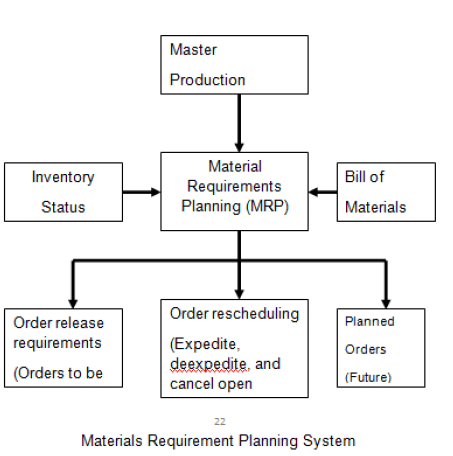 |
| (IV) Increased efficiency: |
| MRP provides close coordination among various work centers as products progress through them. Consequently, production can proceed with fewer indirect personnel, such as materials expeditors, and with fewer unplanned Interruptions because MRP focuses on having components available at appropriately scheduled times. The information provided by MRP encourages production efficiencies. “Inventory control is exercised when you order an item. If you do a poor job, then everything after is inventory correction” |
References |
 |